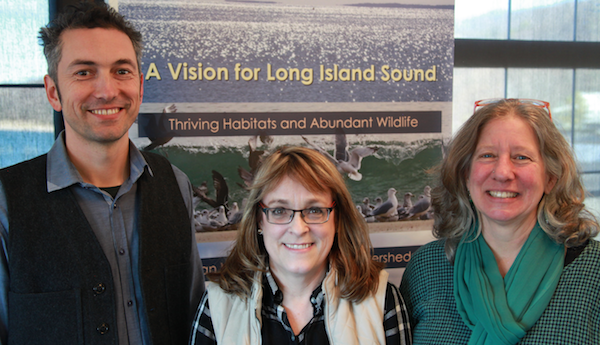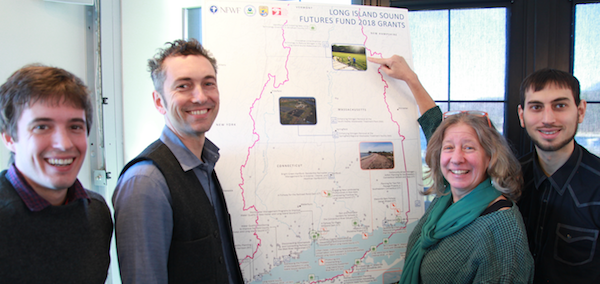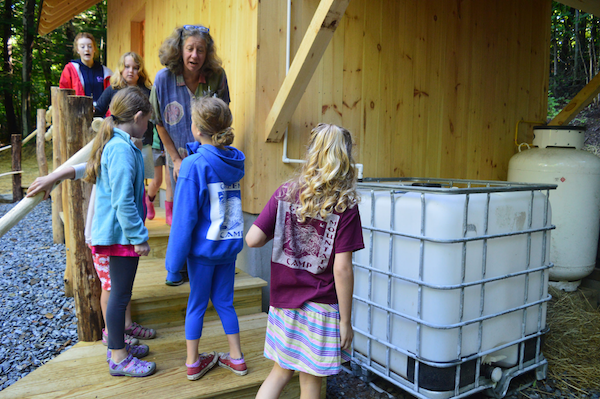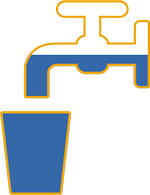Back to all articles
Rich Earth Institute Receives Multiple Awards From the Long Island Sound Future’s Fund

Lynn Dwyer of LISFF, along with Kim Nace and Abe Noe-Hays of the Rich Earth Institute at the LISFF Award Ceremony.
The Rich Earth Institute is proud to announce multiple grants totaling approximately $145,000 from the National Fish and Wildlife Fund’s Long Island Sound Futures Fund to divert nitrogen from the Connecticut River Watershed. While Rich Earth Institute was the only Vermont organization to receive an award, 36 grants totaling $2.57 million were distributed to groups throughout NY, CT, MA, and VT to improve the overall health and ecosystem of Long Island Sound. This grant program combines funds from the EPA and National Fish and Wildlife Foundation (NFWF) and involves monies for both implementation of programs and planning for expansion of those programs in the future.

The Rich Earth Institute team; Arthur Davis, Abe Noe-Hays, Kim Nace and Jed Blume, posing alongside a map of all 36 grant awards.
“This is the first time we have received funding specifically to collect more urine”, said Abe Noe-Hays, Research Director at the Institute, “and we have recently added additional farms and equipment in order to accommodate this increase in quantity.”
Why divert urine and collect it? It is rich with exactly the nitrogen, phosphorus, potassium and trace minerals needed in agriculture to fertilize crops. With 1,000 gallons of urine, 50 pounds of synthetically produced nitrogen can be replaced in fertilizing one acre of hay. Diverting 1,00 gallons of urine from the waste stream conserves approximately 31,200 gallons of potable flush water. Flushing the nutrients in urine means they end up in ground and surface waters causing pollution and damaging aquatic ecosystems. Treatment plants remove some of these nutrients, but the cost of nutrient removal equipment is a heavy burden for our municipalities. Rich Earth argues: why not keep those nutrients out in the first place?! Why do we waste drinkable water in this way?

The Green Mountain Girls Camp – installed the first public, permanent urine collection system in their new bathhouse in 2018 and collected over 100 gallons of urine.
Rich Earth Institute has been conducting research and demonstrating this approach since 2012, and continues most of its research with support from the National Science Foundation. This new funding will enable Rich Earth to double the volume of nutrients recovered and returned to local hay fields. In 2018, a lot of energy was put into building capacity and ramping-up, and with these new funds, the Rich Earth Institute can add institutional partners who are interested in permanent, large-scale installations of urine-diverting toilet systems (UDTs). If your organization has bathrooms that receive high foot traffic and are interested in learning more about partnering with Rich Earth Institute for a demonstration project, contact for more information.
Rich Earth is grateful to the significant numbers of early adopters and committed local urine donors who helped us collect almost 7,000 gallons in 2018. For $30, new donors in the Brattleboro area are invited to purchase a simple, portable urinal (a 5 gallon plastic jug, nuns cap, and funnel). At the Urine Depot on Birge Street in Brattleboro you will find a notebook inviting you to join the friendly “Piss off” competition by recording your contributions. To learn more about becoming a urine donor email: Arthurrichearthinstitute.org. With this round of funding by the Long Island Sound Futures Fund, many more individuals and organizations can participate.
A ceremony was held recently in Port Jefferson, NY to recognize all 36 recipients of this year’s funding; officials from various federal departments and legislators attended. “EPA is committed to working with conservation partners and local communities to protect and restore iconic waters like Long Island Sound that are among our nation’s most precious natural resources,” said EPA New England Regional Administrator Alexandra Dunn.
Since 2005, the Long Island Sound Study (LISS), developed under the EPA’s National Estuary Program, has invested $19.6 million in 416 projects. The projects have opened up 163 river miles for fish passage, restored 1,109 acres of critical fish and wildlife habitat and open space, treated 204 million gallons of pollution, and educated and engaged 4.7 million people. Rich Earth Institute’s project will entail an expanded effort to divert more urine in Windham County, and planning for efforts in 2020 to grow along the run of the Connecticut River Watershed .
Kim Nace, Executive Director of the Rich Earth Institute is eager for the challenge and tells the community to, “Expect a special event in the Spring to kick off the 2019 collection efforts. Windham County is leading Vermont and the country in the development of urine diverting, alternative waste management infrastructure. We’re turning urine into a valuable and locally-used resource for our farmers, and saving water while we do it. As early adopters, eyes are on our community as we grow and refine our operations, refining the model for replication in other locations. “

